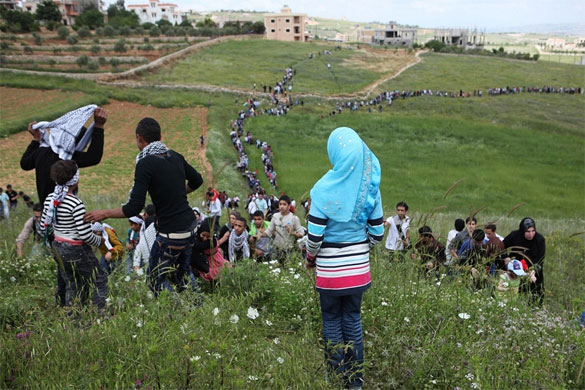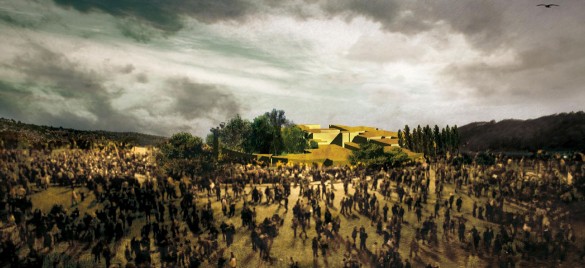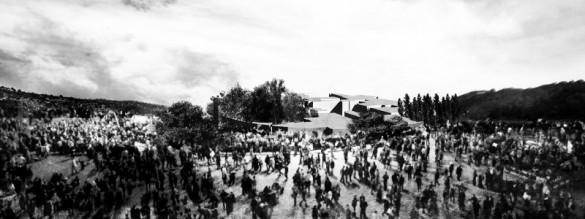This past weekend the world watched as Palestinians in Lebanon, Syria, Jordan, Gaza and the West Bank marched on the recognised and unrecognised borders of Israel to mark Nakba Day. This by no means represents the first attempt by Palestinians to return to their homeland. In fact, against the odds, many thousands risked their lives to return to their homes in the weeks and months during and immediately following the hostilities of 1948. Estimates suggests that around 25,000 managed to return during this period,(1) although 3000-5000 were killed in their attempts to cross the armistice lines.(2)

Yet, on the back of 20 years of political ‘negotiations’ that have all but ignored the rights of Palestinian refugees in particular, 15th May 2011 does indeed represent a watershed moment. It marks the date when, spurred by the popular uprisings in the Arab world around them, a new generation of Palestinians asserted themselves as the authors of their own future. As remarked by Jonathan Cook (journalist and author of Disappearing Palestine):
Unlike previous years, this Nakba Day was not simply a commemoration of the catastrophe that befell the Palestinians in 1948, when their homeland was forcibly reinvented as the Jewish state. It briefly reminded Palestinians that, despite their long-enforced dispersion, they still have the potential to forge a common struggle against Israel.(3)
Admittedly, the immediate events of the past few days may have been met with violent repression (up to now, 13 are confirmed dead). But, in their aftermath, reports from all directions suggest that the global Palestinian struggle has simply been emboldened.(4) And, ultimately, the Israeli military apparatus has demonstrated that it has no real answer should this mass non-violent movement grow. Aluf Benn, editor-at-large of Haaretz, wonderfully summarises the despair of the Israeli establishment:
[…] the nightmare scenario Israel has feared since its inception became real – that Palestinian refugees would simply start walking from their camps toward the border and would try to exercise their “right of return.”(5)

In this moment of seemingly unlimited possibility, where Al-Awda (‘The Return’) suddenly moves from a nostalgic imaginary to something both tangible and realisable, we are forced to engage in new ways with the spatial, political and social landscapes of Israel-Palestine. Instead of asking “can we return?” or “when will we return?”, Palestinians are suddenly allowed to ask “what kind of return do we want to create for ourselves?”.
What seems evident is that Al-Awda will not be a return to the rural villages of pre-1948 Palestine as so many nostalgic narratives depict. 63 years on from the beginning of Al-Nakba, the majority of these villages have long since been destroyed, and a Palestinian refugee population of 750,000 has grown to a worldwide diaspora of nearly 7 million.(6) In a territory that is already one of the most densely populated on the planet, this suggests a ‘return’ instead to a distinctively urban landscape.

Over the past few years, a number of initiatives have already begun to grapple with the architectural/spatial dimensions of return. The work of geographer Salman Abu Sitta asserts the fundamental feasibility of a wholesale return of Palestinian refugees,(7) whilst the work of Zochrot has begun to consider the possible stages of return and the challenges of integrating the Palestinian and Israeli socio-political space,(8) whilst DAAR (Decolonizing Architecture Art Residency) have attempted to re-imagine the destroyed Palestinian villages as fragments of a new urban realm, and to consider the reciprocal implications for the refugee camps currently embedded in cities across the Arab world.(9) A collection of architectural projects inspired by this work have already been featured on this site.
As a project and a platform, the purpose of arenaofspeculation.org is to narrate the implicit possibilities of the countless acts of ‘spatial resistance’ that are continually being played out in Israel-Palestine, and to assert architecture and planning as tools of empowerment in this struggle for rights and justice. In this spirit, over the coming weeks we will be working to frame an open and collective project for imagining Al-Awda, not only as a means to consider the possibilities for a permanent return of refugees, but also as a vehicle for re-imagining the broader spatio-political contours of Israel-Palestine, and challenging the logic of division and exclusivity of space that has fragmented its physical and human geography and all but severed its connections with the Arab world beyond.

We will be attempting to build on our links with various individuals and organisations to make this initiative possible. If you would like to contribute, or to find out more, please get in touch at info [at] arenaofspeculation.org
(The images on this page are reproduced with kind permission from the authors.)
End Notes
1. See Benny Morris, The Birth of the Palestinian Refugee Problem Revisited, p.577 (cited on Wikipedia).
2. See Mazin Qumsiyeh Popular Resistance in Palestine: A History of Hope and Empowerment, p.98.
3. Jonathan Cook, On an old anniversary, a new sense that change is possible
4. For example, Al-Awda (The Palestine Right to Return Coalition) issued a statement saying “The Nakba is not simply a day when we commemorate a memory once a year, rather it is ongoing, hence the events and marches of return will last as long as the Nakba continues, and until we bring about a return to our original homes.”
5. Aluf Benn, The Arab Revolution is knocking at Israel’s door
6. In 2009, Badil (Resource Center for Palestinian Residency and Refugee Rights) recorded a figure of 6.6 million Palestinian refugees, excluding internally displaced persons, see Survey of Palestinian Refugees and IDPs (2008-2009), p.56.
7. Salman Abu Sitta, Palestine Right Of Return: Sacred, Legal, and Possible
8. A multi-lingual edition of Sedek: The Journal of the Ongoing Nakba, was published recoently by Zochrot, bringing together a collection of articles on return from their previous publications. Featured on this site.
9. The DAAR project, entitled ‘Returns’ is summarised on their website (pages: intro, 1, 2, 3, 4)

7 replies on “Planning Al-Awda: Re-Imagining the Spatial Contours of Israel-Palestine”
[…] myth that is the most explosive: that a literal return is unfeasible. In the words of the excellent arenaofspeculation.org, engaging “in new ways with the spatial, political and social landscapes of […]
[…] myth that is the most explosive: that a literal return is unfeasible. In the words of the excellent arenaofspeculation.org, engaging “in new ways with the spatial, political and social landscapes of […]
[…] a dynamic "arena of speculation", as the name of another fascinating website/initiative by Ahmad Barclay and colleagues that deals with this central issue–critical perspectives on spatial futures of […]
[…] "זירה של ספקולציות", כשמו של אתר מרתק נוסף העוסק בנושא זה, חיונית […]
The Palestinian People need to find some railway box cars and place them in the center of town.
Each time a victim is killed or wounded by Israeli agression, the victims need to be placed in these box cars.
It is images of Jews being herded into box cars during WWII which haunts the Western mind.
Calm
[…] that is the most explosive: that a literal return is unfeasible. In the words of the excellent arenaofspeculation.org, engaging “in new ways with the spatial, political and social landscapes of […]
Calm – Although I appreciate your desire to influence the attitudes of citizens of ‘Western’ countries, in this article we are trying to focus more on the possibilities that Palestinians themselves have to shape their own future. As such, it is not this remote ‘audience’ that matters, but their belief in what they can achieve much more directly through their own actions.